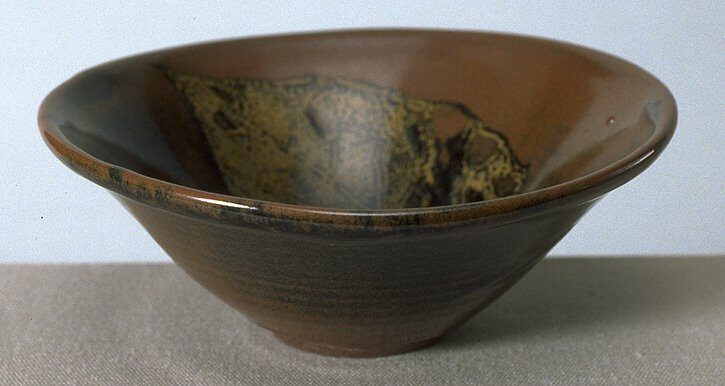Teabowl with leaf stencil design
Arao Tsunezô

Description
2. Arao Tsunezô
Japan, active 1950–1970
Tea bowl
Showa period (1926–1989)
circa 1960
Stoneware with tenmoku glaze
Museum purchase, 1965/1.155
3. Hara Masao
Japan, 20th century
Tea bowl
Showa period (1926–1989)
circa 1975–80
Stoneware with oil spot tenmoku glaze
Gift of Mr. Masao Hara, 1980/2.164
4. Katô Kôbei
Japan, 1893–1982
Narrow-necked bottle
Showa period (1926–1989)
circa 1950–63
Stoneware with oil spot tenmoku glaze
Gift of the artist, 1963/2.66
Deep black and brown glazed tenmoku ware was highly prized in the Imperial court of the Chinese Northern Song dynasty (960–1127). Produced in the Jian kilns in Fujian, this type of pottery was brought to Japan by Zen monks who had studied in Chinese monasteries in the twelfth century; later it was treasured by generations of Japanese tea practitioners. The many variations of these wares—which have names such as yuteki (oil spot) tenmoku and konoha (leaf) tenmoku—require an extremely careful calculation of firing temperatures for successful glazing. The works on display are the result of a long process of trial and error by potters trained to achieve tenmoku variations and other virtuosic effects.
(Turning Point exhibition, Spring 2010)
Among the most rare and celebrated products of the Jizhou kiln in central Jiangxi Province, China are the “tree-leaf pattern” bowls of the Southern Song dynasty (1127–1279). A beautiful pattern is created by placing a leaf on the interior bowl surface before applying the glaze; during firing the leaf turns to ash, creating an image of a golden leaf in the black glaze, as seen in this contemporary Japanese tea bowl and in UMMA 1980/2.167. The technique is extremely difficult to achieve, requiring the perfect combination of skill in applying the glaze and circumstances in the kiln. Over the centuries potters have tried without success to duplicate this process.
---
Deep black and brown glazed tenmoku ware was highly prized in the Imperial court of the Chinese Northern Song dynasty (960–1127). Produced in the Jian kilns in Fujian, this type of pottery was brought to Japan by Zen monks who had studied in Chinese monasteries in the twelfth century; later it was treasured by generations of Japanese tea practitioners. The many variations of these wares—which have names such as yuteki (oil spot) tenmoku and konoha (leaf) tenmoku—require an extremely careful calculation of firing temperatures for successful glazing. The works on display are the result of a long process of trial and error by potters trained to achieve tenmoku variations and other virtuosic effects.
(Turning Point exhibition, Spring 2010)
Subject Matter:
Among the most rare and celebrated products of the Jizhou kiln in central Jiangxi Province, China are the “tree-leaf pattern” bowls of the Southern Song dynasty (1127–1279). A beautiful pattern is created by placing a leaf on the interior bowl surface before applying the glaze; during firing the leaf turns to ash, creating an image of a golden leaf in the black glaze, as seen in this contemporary Japanese tea bowl.
Physical Description:
Teabowl with brown/black tenmoku glaze and golden leaf design on interior.
Usage Rights:
If you are interested in using an image for a publication, please visit https://umma.umich.edu/request-image/ for more information and to fill out the online Image Rights and Reproductions Request Form.